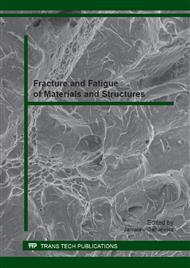[1]
Collins J.A., Failure of Materials in Mechanical Design, Analysis, Prediction, Prevention. John Wiley & Sons, New York 1993.
Google Scholar
[2]
Kocańda S., Kocańda A., Low cycle fatigue strength of metals. PWN Warszawa 1989.
Google Scholar
[3]
Mroziński S., Stabilization of cyclic properties of metals and its influence on the fatigue life. Publisher University of Technology and Life Sciences in Bydgoszcz, Nr 128, Bydgoszcz, 2008.
Google Scholar
[4]
Kaae J.L.: High-temperature low-cycle fatigue of Alloy 800H. International Journal of Fatigue 31 (2009), p.332–340.
DOI: 10.1016/j.ijfatigue.2008.08.002
Google Scholar
[5]
M Mroziński S., Golański G.: Low cycle fatigue of GX12CrMoVNbN9-1 cast steel at elevated temperature. Journal of Achievements in Materials and Manufacturing Engineering. Vol 49 ISSUE 1, November 2011, pp.7-16.
DOI: 10.4028/www.scientific.net/amr.396-398.326
Google Scholar
[6]
ASTM E606-92: Standard Practice for Strain -Controlled Fatigue Testing.
Google Scholar
[7]
PN-84/H-04334: Low-cycle fatigue tests of metals.
Google Scholar
[8]
Vani Shankar, Valerij Bauer, R. Sandya, M.D. Mathew, H.-J. Christ.: Low Cycle fatigue and thermo-mechanical fatigue behavior of modified 9Cr-1Mo ferritic steel at elevated temperatures, Journal of Nuclear Materials vol. 420 (2012), pp.23-30.
DOI: 10.1016/j.jnucmat.2011.08.048
Google Scholar
[9]
Mroziński S., Skocki R., Softening of Martensitic Cast Steel, Journal of Polish CIMAC. Volume 5 No 3, 2011, pp.173-180.
Google Scholar
[10]
Mroziński S., Golański G.: Fatigue life of GX12CrMoVNbN9-1 cast steel in the energy-based approach. Advanced Materials Research. Vol 396-398 (2012), pp.446-449.
DOI: 10.4028/www.scientific.net/amr.396-398.446
Google Scholar
[11]
Coffin L.F., A study of the effects of cyclic thermal stresses on a ductile metal. Trans. ASME 76, 1954, pp.931-950.
DOI: 10.1115/1.4015021
Google Scholar
[12]
Manson S.S., Behaviour of materials under conditions of thermal stress. NACA TN –2933, 1953.
Google Scholar
[13]
Mroziński S., Skocki R. Influence of temperature on the cyclic properties of martensitic cast steel. Fatigue Failure and Fracture Mechanics, Materials Science Forum Vol. 726 (2012) pp.150-155.
DOI: 10.4028/www.scientific.net/msf.726.150
Google Scholar


